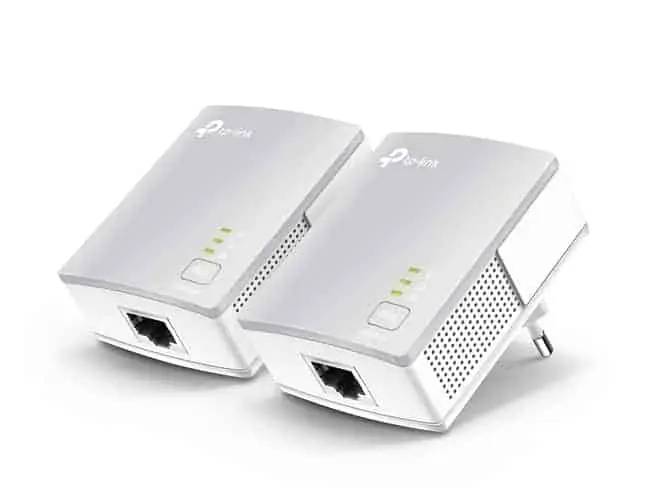What options are available if your Wi-Fi is weak in just one room? The signal seems fine in most parts of the house, but just one room is bugging you as the signal keeps dropping out there?
Here are some quick solutions:
- Try removing any obvious obstacles that may be blocking the signal
- Try moving the router a little if possible
- Try resetting the router to refresh the signal
- Use powerline adapters to bypass Wi-Fi
- Use an extender or mesh system for boosted signals.
Powerline adapters in particular are an excellent solution for solving weak Wi-Fi in the house, whether to one room or several rooms. By using the house’s existing electrical wiring to deliver a strong internet connection to any room in the house, you can target the specific room which is suffering from the weak Wi-Fi and browse, stream and game without any issues.
Which specific type and model of adapter you will need will depend on the number and type of devices you have in the room in question. Standard powerline adapter kits are great for wired devices and come with up to three ethernet ports.
For connecting smaller portable devices like tablets and iPhones then wireless powerline adapters are the model of choice, delivering a strong cloned Wi-Fi access point in your room as well as wired ports. Let’s look at the issue in more detail below.
Wi-Fi Can Be Temperamental
Unfortunately Wi-Fi can be unpredictable and temperamental. Wireless signals belong to the radio frequency or RF spectrum of waves and as such always disperse and weaken over distance as per the inverse square law of physics. So the signal will always tend to get weaker the further you are from the router. The signal also tends to be disrupted the more obstacles it has to pass through, like walls, floors and furniture.
However Wi-Fi can also be confusing as it can seem to work fine in almost every room in the house, with just one room having problems with a weak signal. This room can be far away from the router or even close by, whilst rooms further away can be fine using the Wi-Fi.
This is the temperamental nature of Wi-Fi as there are so many factors which influence how well the signals gets from the router to the device being used. Perhaps there is something about the structure of the wall it has to pass through to get to the room in question, or else some particular object is in the way.
Router technology has improved in recent years so these problems are on the whole less common, though they can still happen in larger or older houses in particular. Let’s look at how we can solve this problem using an underutilized networking solution.
Solution #1 – Powerline Adapters
To solve this problem of weak Wi-Fi to one room, powerline adapters are an ideal solution. They consist of a kit or pair of adapters, one of which you plug in and connect to your router, and the other of which you plug in and connect to your device. The two plugs then communicate using the existing electrical circuitry of the house, delivering a strong wired internet connection to any room in the house you want.
In this way the problem of weak Wi-Fi in that room can be bypassed and you can have a solid, reliable internet connection to that room for gaming, streaming, downloading and other bandwidth intensive activities which need a strong signal.
In many cases they will deliver a connection which is almost as good as if you were plugged directly into the router itself, allowing you to extract the maximum possible bandwidth out of your internet package, as opposed to unreliable Wi-Fi drop outs causing buffering, lag and slow downloads.
Powerline Adapters Explained in 2 Minutes

The TP Link Nano TL-PA4010 Kit model is an entry level, best selling no nonsense powerline adapter model with just one ethernet port and no passthrough. Click to view on our powerline page, plus links to more advanced models from different retailers.
As we have covered in another article, wired connections are always better than wireless ones in terms of reliability and throughput (transfer of data). For general light browsing then there may not be much difference between wired and wireless but once you get to activities which need more bandwidth or less latency, then the difference will be more noticeable.
Wired connections are just preferable; videos play smoother, games don’t lag and pages load faster on wired connections. The browsing experience is just more reliable and speedier on wired connections.
Powerline adapters are an ingenious home networking solution in that they allow the user to get onto a wired connection, even several rooms away from the router, without the need for any expensive (and usually noisy!) DIY work, running long ethernet cables through the house.
They basically do the same job but instead by using the existing electrical circuitry of the house to carry the signal, without needing visible wires trailing through walls or up stairs. The plug and play nature of these devices makes them an excellent option.
Standard powerline adapters provide wired connections only; models come with one, two or three ethernet ports depending on how many devices you want to connect up in the room in question.
For users wanting to also connect wireless devices like tablets, notebooks and iPhones, you will need a wireless powerline adapter model, which has one or more wired ports but also produces a cloned, wireless access point at the receiving end, meaning your portable devices can pick up this much closer and stronger signal rather than the one from the main router.
The wireless powerline adapters are more advanced models in this sense, allowing for more reliable portable browsing by reproducing the Wi-Fi signal from the main router in the room you need it. These models also have at least one ethernet port to connect up any wired devices you have.
They won’t work in all houses as they need good quality house wiring to allow the adapters to communicate, but when when they do work they’re an excellent way of bypassing Wi-Fi altogether.
Solution #2 – Wi-Fi Extenders
If you’re rather keep devices on Wi-Fi, another way to extend wireless coverage to the one room you’re having problems in, is to use a Wi-Fi extender/booster/repeater.
These are simple single plug devices you install in a wall socket that captures and boosts the existing signal from the main router, spreading stronger wireless coverage across an area. If you can find a good place to install the extender near the room with the weak signal, they can be a good solution.

Here’s how you use extenders:
- Plug the device into a socket somewhere mid-way between your router and room you’ve got problems in.
- Connect to the extender’s open network.
- Perform some easy device setup to connect it to the router and set up a new extender network.
- Once configured, you can connect devices in the room to this new (closer and stronger) extender network, which in turn draws off the host router’s network.
See our Extenders page for links to some models in different price ranges.
Alternative Option – Wi-Fi Mesh – More expensive but more advanced versions of Wi-Fi extenders, consisting of 2-3 “nodes” or pods you place around the house, to deliver more comprehensive boosted Wi-Fi coverage. Can be good for larger homes or more widespread signal problems, but you’d be forking out a lot of money for Mesh just to fix a problem with one room.
